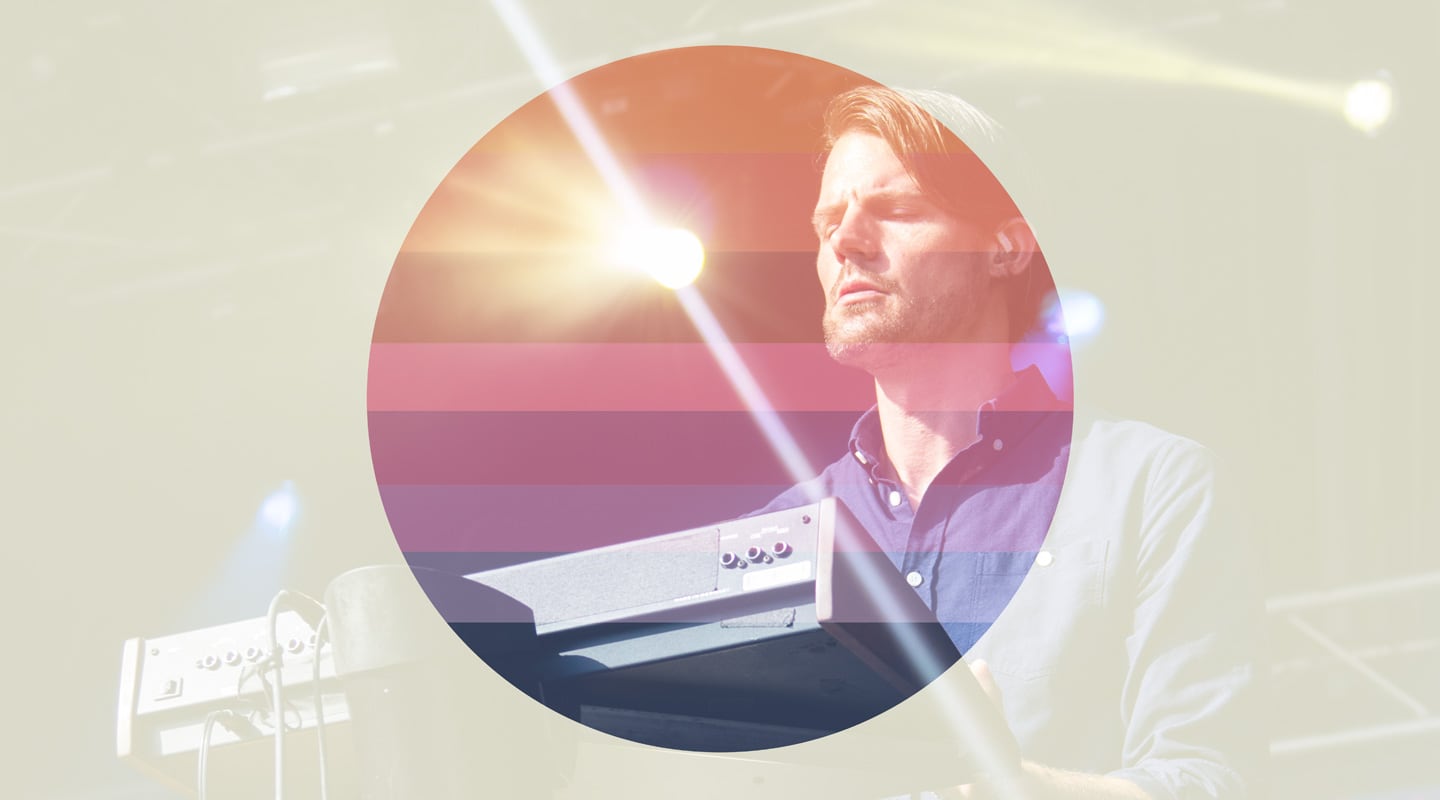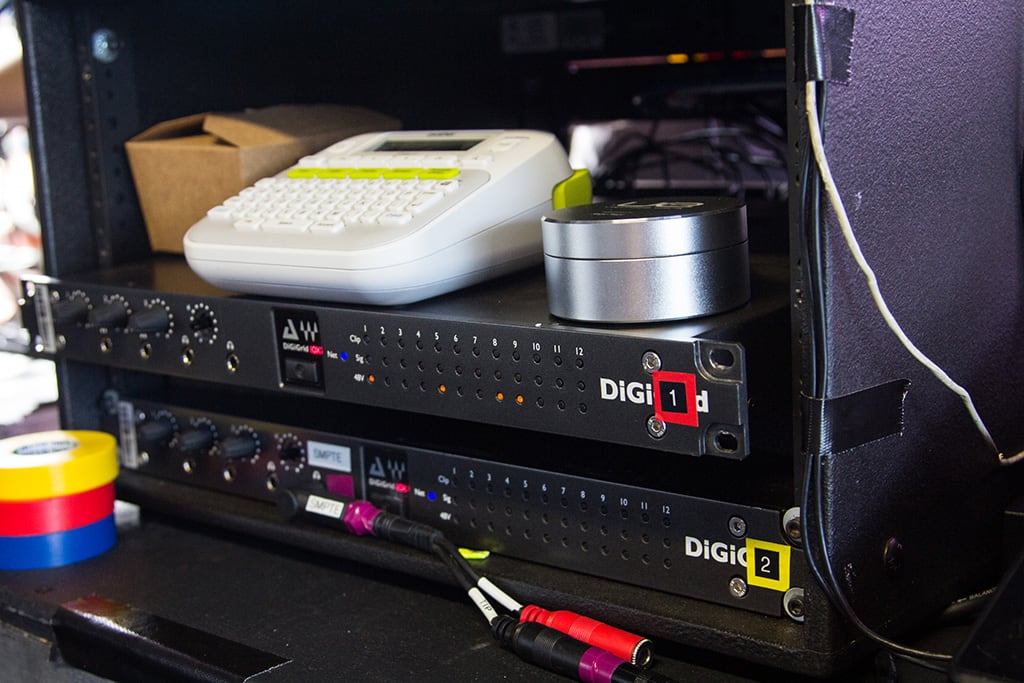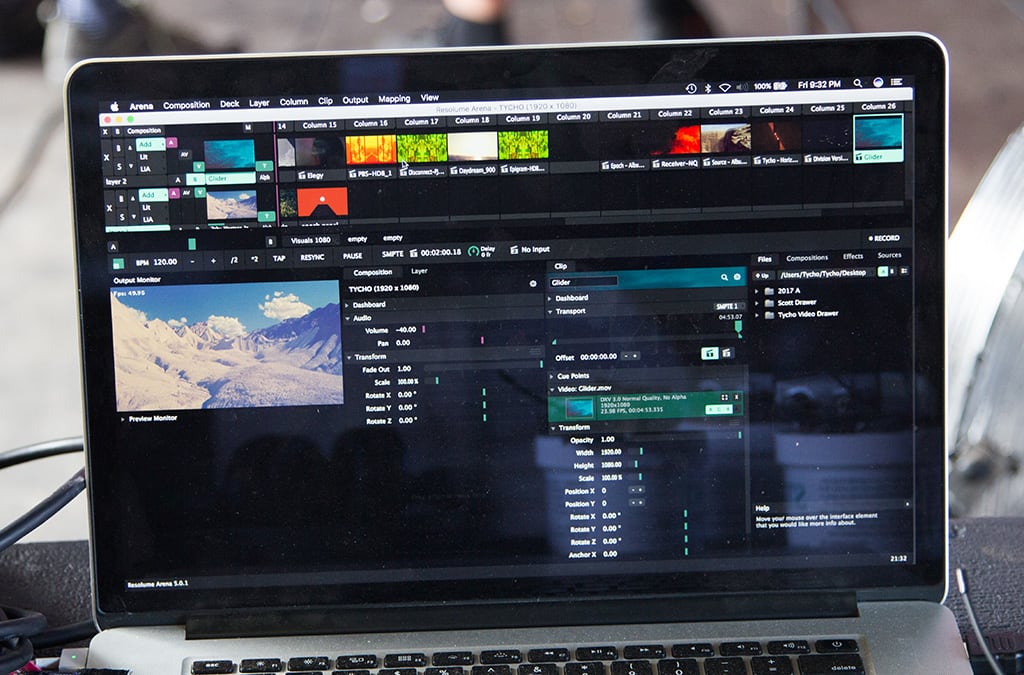
Tycho Rides Waves’ Emotion
Tycho’s music might be chill, but operating monitors is not. Naturally, we were intrigued when we spied Waves’ eMotion LV1 touchscreen system at the position.
Before Scott Hansen started making ambient electronic music under the Tycho moniker, he was a graphic designer with a different pseudonym — ISO50 — working for Adobe (the makers of Photoshop and arguably the epicentre of the design universe). Naturally, visuals play a big role in Tycho’s live show — proportionately relying on the landscapes looping onscreen as it does the soundscapes looping onstage.
It’s equally dependent on screen visuals behind the scenes too. Panning across the trestle tables assembled at side of stage at Laneway in Sydney, there’s a Macbook Pro running Arena — a visual playback engine, a PC laptop taking care of playback via Reaper, and two Dell touchscreens controlling a Waves eMotion LV1 mixing system for monitors.
It’s still rare to see fully-fledged touchscreen-only mixers in the high-stakes world of touring audio, but they’re scarce as hen’s teeth at the monitor position. The de facto standard for digital monitor consoles is probably still the Yamaha PM5D. It’s been hard to shake off its perch not because it sounds superlative, but purely due to its workflow, and plethora of physical knobs and faders. However, all those tactile bits and pieces come at a price; size. A luxury Tycho doesn’t have, explained monitor engineer Sage Plakosh: “We chose the LV1 because we’re doing a bunch of back-to-back fly dates, and we needed our own console that would fit in a really small frame.”
Beyond that, there were two other main selling points: the ability to use Waves plug-ins, and the sound quality. “I have an SSL bus compressor and PAZ Analyzer on every output, and I find it runs Waves plug-ins better than other consoles out there,” said Plakosh. “And the sound quality is really on par with a DiGiCo SD9.”
However, the switch to the LV1 wasn’t without a learning curve. “I started in the business when analogue was king,” continued Plakosh. “Going from tactile to touching the screen for fader moves was definitely new to me.” In fact, he’s already planning on taking a look at some control surfaces when the tour hits Europe and they won’t be doing as many fly dates. The SSL Nucleus is high on his list to check out, as a couple of fellow engineers he knows have used the same combination with success. “I’d like to get to that point for monitors, because of speed,” said Plakosh. “Right now, if I want to get to a channel, I have to select the channel page, select the mix, then select what I’m doing. Half the gig is being able to respond to the musicians’ needs as quickly as possible, and I could be quicker if I had a dedicated surface.”
ORDER FOH TWO
It doesn’t stop there, Tycho’s entire console system is LV1 dependent. “We’re using three DiGiGrid IOX interfaces; two in my rack and one on stage,” outlined Plakosh. “Then we have a DiGiGrid IOC at FOH for routing back to the PA. There’s just a CAT6 cable that runs between us to connect the devices. We share inputs and head amps at the moment, because we don’t have enough I/O to split the signals.”
Plakosh said the first week setting up the system was tough. Because the LV1 platform is open to configuration, when the rig arrived from Brown Note Productions in Colorado it took a while for the crew to bed in their preferences. “You can set it up to play so many different roles,” explained Plakosh. “It was initially configured so when I’d mute something, it’d mute it at FOH. We had to work out a lot in rehearsal.
“From a hardware standpoint, these IOXs get toasty hot. When they originally came to us, they were racked one on top of the other which would generate a lot of heat and start to degrade the reliability, like most electronics. Putting space between them helped a lot. Once we got it under control, we’ve been having a good run with it.”
The Tycho show comprises 16 channels of playback, with cues on top of that. On the live side there are 10 drum inputs, two stereo guitars, mono bass and loads of keyboards, including Korg’s recent Minilogue, which gets a run alongside Hansen’s vintage synth collection. Both positions run a Waves Extreme Soundgrid server to power their plug-ins. It’s almost overkill, as it can run up over 500 instances of a given plug-in. Plakosh uses the LV1’s own EMO plug-ins on all the live inputs, “even if it’s nothing more than high and low pass,” he said. “I also have a basic comp/gate and EQ if I need. The EMO stuff is good. I’m using the SSL EQs for drums because they sound amazing. I’m using the dbx 160 on the kick, which takes a little of the punch out of it, and the API 2500 on guitars, which sounds amazing.”
Out front, engineer Bryan Berge, was bullish about the benefits of using Waves’ LV1 system, saying the sound is, “cleaner and has more headroom,” than other systems. “You can run the Extreme servers on many other systems, but when it’s built into the network, you get super low latency.” Berge explained LV1’s virtual rack system, saying, “you have eight plug-ins per channel, and when you switch over to the next song, you have the same eight plug-ins. It’s more like a rack with built-in hardware. I’ve never really run into any issues, you can get slick with how you route things so if you need something in addition to the eight, you can send it to a matrix or a group and have an additional eight on top without any added latency.
“There aren’t loads of people using it: Dweezil Zappa has it at monitors and FOH, Flume’s using it at monitors, Pitbull at FOH. It’s still pretty new. The nice part about that is we’ve got 24-hour access to Waves’ support team if we’ve got any issues. We’re also giving them input for design and build for the next version.”
We chose the LV1 because we’re doing a bunch of back-to-back fly dates, and we needed our own console that would fit in a really small frame


Sage Plakosh peers out through the smoke to make sure everyone’s happy onstage. His dual screen LV1 setup gives him touch access to all his channels and Waves plug-in parameters.

Scott Hansen is a vintage synth aficionado, yet the diminutive Korg Monologue has found its way into his arsenal.

One of the downsides of flying your console is the TSA can mess with it. Luckily it all worked when Plakosh plugged his DiGiGrid iOX’s back together.

Bryan Berge making final preparations to his LV1 setup before the Tycho show begins.

All the little boxes keeping all the computers in sync — Reaper running playback, and Arena taking care of visuals.


















RESPONSES